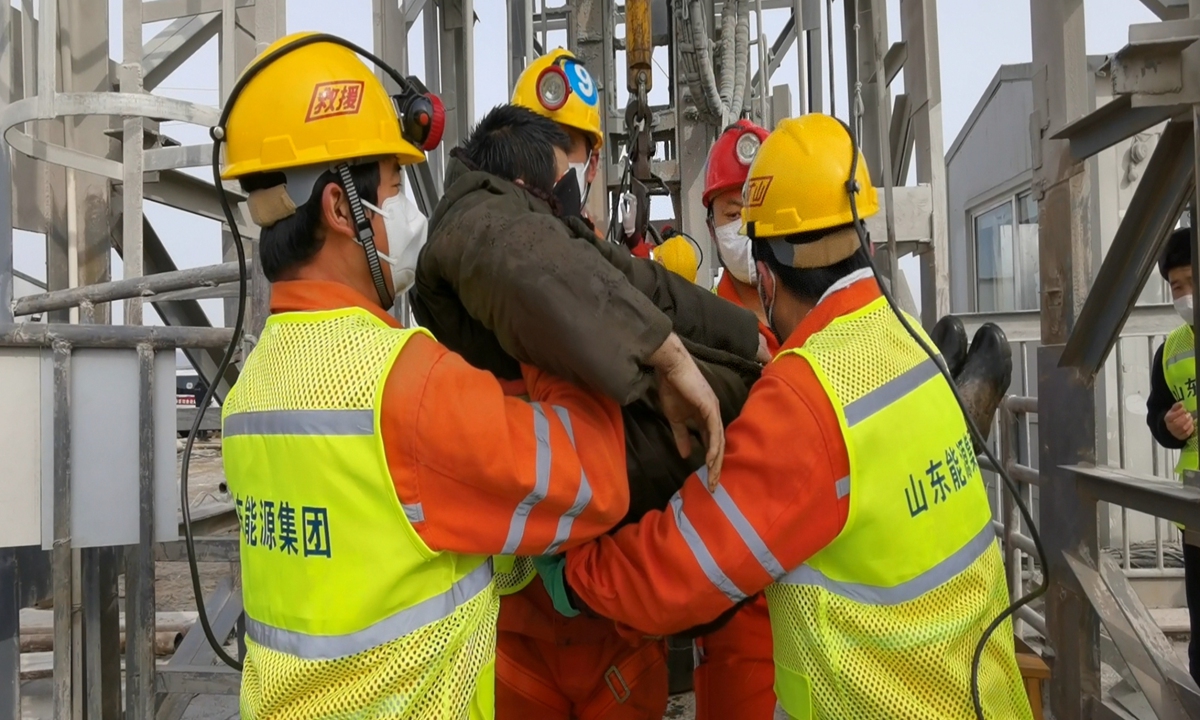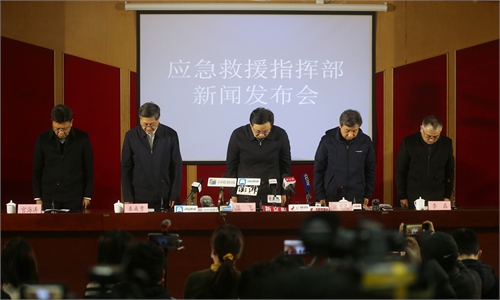'We always believed help would come,' say rescued miners
Miners did not scramble for rescue, but let weaker, older colleagues go up first

Rescuers bring one of 11 trapped miners out of a goldmine in Qixia, East China's Shandong Province on Sunday. All 11 miners who had established contact with rescuers had been brought to the surface as of 3:18 pm on Sunday. Search and rescue operations for another 10 missing miners is ongoing. (See story on Page 4) Photo: Xinhua
Two days after 11 miners were rescued from a fatal goldmine explosion in Qixia, East China's Shandong Province, the miners spoke up about memories of their time down the shaft and faith in the rescue. "We always believed help would come," the miners said on Tuesday.
On Sunday, the rescuers brought the 11 miners to the surface. Some of the miners were able to walk to the ambulance with the help of the rescuers. One rescued miner held his hands together as a gesture to thank the rescuers, and one shouted, "Tell my family I'm still alive!"
The miners told state media Xinhua News Agency on Tuesday about their faith during the accident and the rescue. "We always believed that rescue teams would come for us."
"When the explosion took place, we only heard a loud sound and could not see anything. The shock wave of the explosion swept us far away. Our helmets were shattered." One of the rescued miners using the pseudonym Wang Kang recalled, "After the explosion, we rushed to find each other."
Another rescued miner Du An was working at the Sixth Central Section, the deepest part of the mine, when the first explosion took place. Du and other miners in the section managed to climb to the Fifth Central Section before a second explosion happened.
"Some decided to climb further up the shaft, and planned to send a signal to us if they made it there safely," Du said. However, they never received any signal, so the other miners stayed in the Fifth Central Section.
Of the 11 rescued miners, 10 were found in the Fifth Central Section. Eight miners were found dead in the Third Central Section and the Fourth Central Section, which were closer to the surface. Judging by the bodies, some of the miners starved to death, and some died from injuries from the explosion, on-site chief rescue expert Du Bingjian told the Global Times.
Since meals are usually delivered at a fixed time during daily underground operations, the miners did not have any food reserves.
Since meals were usually delivered at a fixed time during daily underground operations, the miners did not have any food reserves.
"There was underground water, but it was not suitable for human consumption. We only drank some occasionally to stay alive," Du An said.
After days of waiting, a hole was drilled through.
"At that time we had not eaten for days, but we were so thrilled that we stood up."
In the following days, nutritional solutions, food, fruit and clothes were sent down the shaft, and the miners gradually recovered. Rescuers even sent down Laba Porridge, a special festival dish containing a nutritious mix of grains, beans, millet and other ingredients for the miners.
The survival environment in the mine was generally good, with clean resting and sleeping conditions, Du Bingjian told the Global Times.
Through a camera sent by the rescue team down the shaft, Du saw that the miners were squatting against the wall and eating on the ground when meals were sent down. After their meals, the miners tried to rest as much as possible in order to save energy.
"There was also a large area to walk, about 300 meters in length, where the miners would do basic exercises," Du said. "There was water in some areas, but it was not very deep, and it only covered the tops of their feet."
The temperature at the bottom of the mine was also very warm. The miners down the shaft said that most of their clothes were still dry and everyone was still fully dressed.
On Sunday, the rescue channel was successfully drilled. The 10 rescued miners in the Fifth Central Section did not scramble to ascend the shaft, but let the older and weaker miners go up first.
Wang was among the last to ascend. He was wearing a black eye patch. After hearing applause and cheers, he put his hands together to express gratitude. The rescued miners were immediately transferred to a hospital.
The mine explosion in Qixia took place on January 10, and 22 miners were trapped. As of Tuesday, 11 miners had been brought to the surface, with 10 confirmed dead and one still missing. The rescued miners are receiving treatment at Qixia City People's Hospital.
Five of the 11 rescued miners are in a stable condition and do not need medication. Four are in relatively good health, but are receiving medication due to existing conditions. Two suffered serious — but not life-threatening — injuries, officials said at Monday's news conference.


